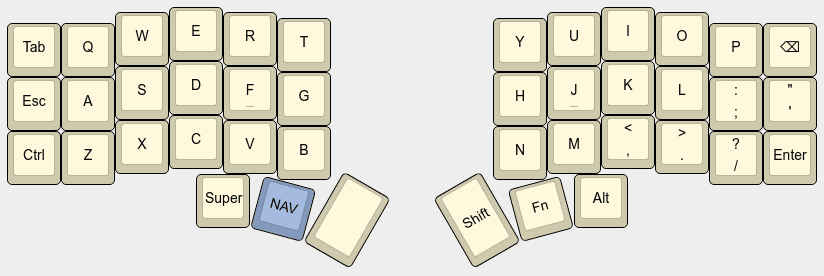Layer Lock
Some layer switches access the layer by holding the key, including momentary layer MO(layer) and layer tap LT(layer, key) keys. You may sometimes need to stay on the layer for a long period of time. Layer Lock "locks" the current layer to stay on, supposing it was accessed by one of:
MO(layer)momentary layer switchLT(layer, key)layer tapOSL(layer)one-shot layerTT(layer)layer tap toggleLM(layer, mod)layer-mod key (the layer is locked, but not the mods)
Press the Layer Lock key again to unlock the layer. Additionally, when a layer is locked, layer switch keys that turn off the layer such as TO(other_layer) will unlock it.
How do I enable Layer Lock
In your rules.mk, add:
LAYER_LOCK_ENABLE = yesPick a key in your keymap on a layer you intend to lock, and assign it the keycode QK_LAYER_LOCK (short alias QK_LLCK). Note that locking the base layer has no effect, so typically, this key is used on layers above the base layer.
Example use
Consider a keymap with the following base layer.

The highlighted key is a momentary layer switch MO(NAV). Holding it accesses a navigation layer.

Holding the NAV key is fine for brief use, but awkward to continue holding when using navigation functions continuously. The Layer Lock key comes to the rescue:
- Hold the NAV key, activating the navigation layer.
- Tap Layer Lock.
- Release NAV. The navigation layer stays on.
- Make use of the arrow keys, etc.
- Tap Layer Lock or NAV again to turn the navigation layer back off.
A variation that would also work is to put the Layer Lock key on the base layer and make other layers transparent (KC_TRNS) in that position. Pressing the Layer Lock key locks (or unlocks) the highest active layer, regardless of which layer the Layer Lock key is on.
Idle timeout
Optionally, Layer Lock may be configured to unlock if the keyboard is idle for some time. In config.h, define LAYER_LOCK_IDLE_TIMEOUT in units of milliseconds:
#define LAYER_LOCK_IDLE_TIMEOUT 60000 // Turn off after 60 seconds.Functions
Use the following functions to query and manipulate the layer lock state.
| Function | Description |
|---|---|
is_layer_locked(layer) | Checks whether layer is locked. |
layer_lock_on(layer) | Locks and turns on layer. |
layer_lock_off(layer) | Unlocks and turns off layer. |
layer_lock_invert(layer) | Toggles whether layer is locked. |
Representing the current Layer Lock state
There is an optional callback layer_lock_set_user() that gets called when a layer is locked or unlocked. This is useful to represent the current lock state for instance by setting an LED. In keymap.c, define
bool layer_lock_set_user(layer_state_t locked_layers) {
// Do something like `set_led(is_layer_locked(NAV));`
return true;
}The argument locked_layers is a bitfield in which the kth bit is on if the kth layer is locked. Alternatively, you can use is_layer_locked(layer) to check if a given layer is locked.
Combine Layer Lock with a mod-tap
It is possible to create a mod-tap MT key that acts as a modifier on hold and Layer Lock on tap. Since Layer Lock is not a basic keycode, attempting MT(mod, QK_LLCK) is invalid does not work directly, yet this effect can be achieved through changing the tap function. For example, the following implements a SFTLLCK key that acts as Shift on hold and Layer Lock on tap:
#define SFTLLCK LSFT_T(KC_0)
// Use SFTLLCK in your keymap...
bool process_record_user(uint16_t keycode, keyrecord_t *record) {
switch (keycode) {
case SFTLLCK:
if (record->tap.count) {
if (record->event.pressed) {
// Toggle the lock on the highest layer.
layer_lock_invert(get_highest_layer(layer_state));
}
return false;
}
break;
// Other macros...
}
return true;
}In the above, KC_0 is an arbitrary placeholder for the tapping keycode. This keycode will never be sent, so any basic keycode will do. In process_record_user(), the tap press event is changed to toggle the lock on the highest layer. Layer Lock can be combined with a layer-tap LT key similarly.